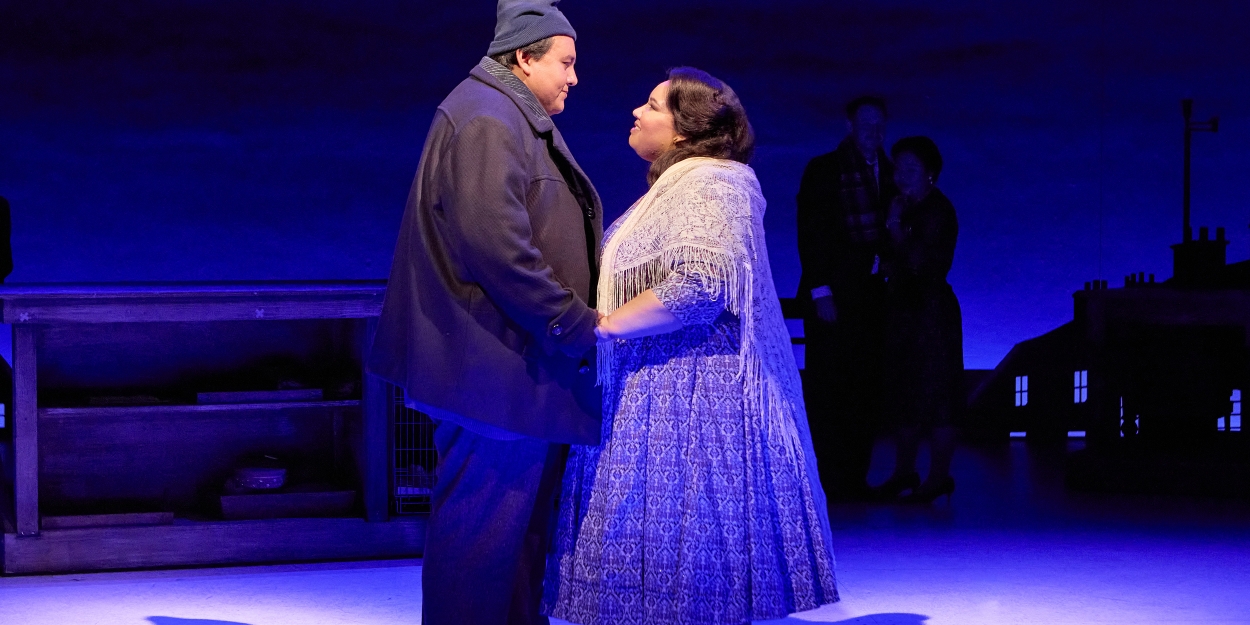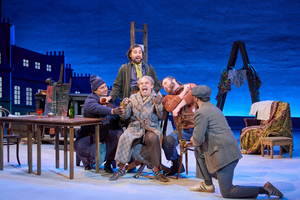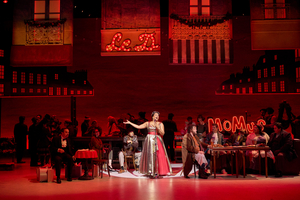Review: LA BOHEME at Opera Theatre Of Saint Louis
OTSL's brilliant production runs through June 30.

Opera Theatre of St. Louis continues their forty-ninth season with a superb production of Puccini’s masterpiece, La Bohème—his most beloved work. The occasional sprinkle of very light rain seemed to refresh rather than deter those dining on the lovely grounds. Again the theatre was packed to the rafters with eager opera lovers. They were not disappointed.
This production has made me fall in love with Puccini for (I’d say) the hundredth time.
Puccini, writing in the 1890s, had done away with much of the rigid structure of operas written earlier. He wrote in the verismo style—a style of realism, portraying the lives of ordinary poor people. In Bohème he discards that obsolete form, the overture; he dives right into the action with a dramatic, descending four-note phrase: “Ba-dom-pom-POM”—and instantly we’re there in the icy garret of four cold-and-hungry but merry room-mates. They are Marcello, an artist; Rodolfo, a poet; Colline, a philosopher; and Schaunard, a musician.
It's a striking—a wonderful sight as the curtain rises! Scene designer Takeshi Kata places this garret against a background of those iconic Haussmann buildings—in black silhouette but with lighted windows. Behind and above—a vast gray sky. The garret is fragmented, with only the slightest gesture at walls, but it’s richly detailed. It’s all beautifully theatrical.
We m eet two, then three, then all four of these creative but definitely not-yet-successful men. What a team! We have Thomas Glass as Marcello, Moisès Salazar as Rudolfo, Titus Muzi III as Schaunard, and André Courville as Colline. Their voices, their energies, their styles are so remarkably well-matched! And stage director Michael Shell keeps them in lively, friendly, natural movement throughout the scene. They tease and joke as they try to coax a little warmth out of the stove by feeding it Act I, then Act II of Rodolfo’s unproduced verse drama.
eet two, then three, then all four of these creative but definitely not-yet-successful men. What a team! We have Thomas Glass as Marcello, Moisès Salazar as Rudolfo, Titus Muzi III as Schaunard, and André Courville as Colline. Their voices, their energies, their styles are so remarkably well-matched! And stage director Michael Shell keeps them in lively, friendly, natural movement throughout the scene. They tease and joke as they try to coax a little warmth out of the stove by feeding it Act I, then Act II of Rodolfo’s unproduced verse drama.
Robert Mellon shows his terrific vocal and comic gifts as Benoit, the landlord, who charges in demanding the back rent. He’s a delight.
Director Shell has brought the story up from the 1840s to the 1950s. Why? That’s a puzzle, but it doesn’t greatly impact much: this garret hasn’t been painted (or perhaps cleaned) since the 1840s. But wait a minute! Shell’s 1950s garret has electric lights, but Mimì has to appear at the door asking for a match to light her candle!? No problem! A power failure puts the whole building in darkness. (Remember power failures? Aren’t they romantic and spooky?!)
Mimì, that girl at the door seeking en-lightenment, is sung by Katerina Burton. Now Puccini, in this early scene, hits us with three of his most utterly irresistible arias: “Che gelita manina” (where Rodolfo warms her tiny frozen hand), “Si, mi chiamano Mimì” (where she introduces herself), and “O soave fanciulla” (“Oh, lovely girl!”). The glorious voices of Salazar and Miss Burton fill this music with heart-breaking sweetness. Each seems to relish the lofty elevation of those highest notes, where their voices virtually glow with easy power. I felt I was hearing these songs for the first time.
(The opera at OTSL is sung in an excellent English translation, but I refer to arias by their Italian names, which are more familiar to most opera fans.)
Now I love having a scene change done by the cast; it makes less of an interruption to the story than when the curtain comes down or when the change is done by black-clad stage hands pretending to be invisible. But the handling of the end of Act 1 is utter genius! Chorus members drift on, unhurriedly, in the dimming light, and when the orchestra rises in a great crescendo every stick of furniture in the garret lifts up and away, as if borne on that great wave of music! It’s the most inspired scene change I’ve ever watched in nigh on seventy years of theater-going. I suspect that director Shell had more than a little help with this from that great choreographer, Seán Currin.
The crowd! A stageful of Parisians—of all classes and ages—meet us on the street outside the Café Momus. There must be fifty people there. They are richly varied, boisterous, busy. There are those dashingly be-kepied and be-caped police “flics”; there are a gaggle of street ragamuffins. The kids crowd and gabble around Parpignol, the toy-seller, who’s blessed with a brilliant mock-military costume (Harlequin pants, vividly comic bi-corn hat). This role is deliciously played by Levi Adkins.
Costumer Amanda Seymour does ravishing work in this very challenging scene.
And the n there is (drumroll, please): Musetta! She’s Marcello’s on-again-off-again lover. She’s a flirt, a temptress, a fickle siren, and she’s beautifully sung by the vivacious Britany Renee. She gives us that show-stopper, “Musetta’s Waltz”, from a well-deserved crisp cabaret spotlight pool.
n there is (drumroll, please): Musetta! She’s Marcello’s on-again-off-again lover. She’s a flirt, a temptress, a fickle siren, and she’s beautifully sung by the vivacious Britany Renee. She gives us that show-stopper, “Musetta’s Waltz”, from a well-deserved crisp cabaret spotlight pool.
So it’s definitely the vocal A-team singing in this Bohème. They’re all so fine! But, if pressed, I would give special praise to Moisés Salazar. He fills Rodolfo with a memorably strong and golden tenor.
Marcus Doshi gives us lovely, mood-sensitive lighting.
Maestro José Luis Gỏmez leads the fine orchestra to explore even the subtlest emotional nuances of these songs. He’s a master of controlled dynamics. Very often an instrument—often a violin—becomes a partner with the singers, echoing wistfully the deep feelings of the characters.
During the intermission something strange is happening to the visual and societal aspects of the show. Every drop of color is suddenly drained from the show—set, costumes, even lighting. It’s all black and white and gray. Act 3 shows a street outside a bar. It’s snowing, so we don’t expect a lot of flowers, but this is so stark. Even those Haussmann buildings are just gone! A worker is scrubbing graffiti from a low wall at the rear. It says, in blood-red smears, “L’AMOUR EST MORT”. (This is certainly not in the libretto.) This is all a rather brutal—even Stalinist—intrusion into Puccini’s oh-so-romantic story.
Act 4 shows us the garret, but what a change! Is it even the same garret? It’s been disorientingly rearranged. All the detail is gone. There is no stuff! Even Marcello’s paintings: one is just blank canvas, another is not even stretched—just drooping in blank folds on the easel.
The director’s note justifies this with comments about the “abstraction and expressionism’ occurring in art at that time in the ‘50s. But what has that to do with Mimì’s death? That final scene of grief and mourning is dark, yes, but it is surely most deeply hued. You cannot jerk the romance out of Puccini without agony.
(And about that shift in time: Puccini doesn’t specify Mimì’s illness, but we all know that it is that affliction that was so artistically fashionable in the 19th Century—“consumption”. To place the story in the 1950’s means that she can only be dying of “TB”—so clinical and unromantic.)
Despite these strange treatments in its second half, La bohème at Opera Theatre of Saint Louis is a must-see for any lover of opera. It continues through June 30.
(Photos by Eric Woolsey)
Reader Reviews
Videos

